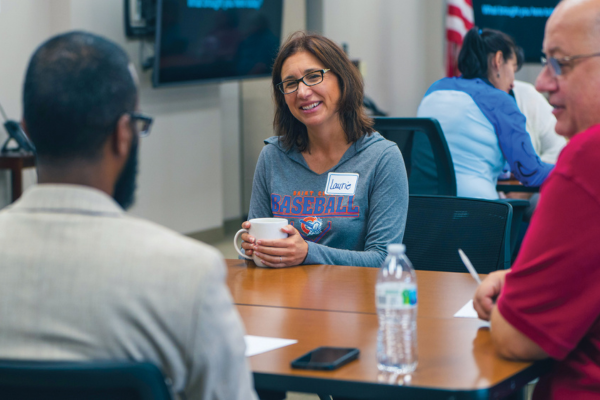C.J. Reid and Lori Vines on Membership
September 01, 2017

Inside AASA
AASA’s two-person membership department attends to the nuts and bolts of the organization. Unlike AASA’s other departments, this one doesn’t deliver services such as legislative advocacy or professional training. Rather, the unit is responsible for attracting new members and retaining current members through customer service and marketing.
C.J. Reid, associate executive director for governance, membership and affiliate services, focuses on the big picture. For Lori Vines, the assistant director, the devil is in the details.
Reid oversees association support for AASA’s
governance structure, attending to needs of the Governing Board and Executive Committee and works closely with state associations.
Vines manages membership operations and maintains the member database, ensuring accuracy and processing renewals
in a timely way.
The following interview by AASA staff member Rebecca Shaw has been edited for length and clarity.
What effect did AASA’s rebranding campaign have on membership?
Vines: The intent of leadership was to position AASA to be more focused on the superintendent. Prior to the name change, we were the American Association of School Administrators and superintendent didn’t stand out in the name.
Programs such as the Aspiring Superintendents Academy® give strength to our current name (AASA, The School Superintendents Association).
Reid: This campaign totally strengthened the brand. AASA should be the home
for those who aspire to the superintendency. If what you want to be is a dynamite high school principal, then we are not the right place for you. But if you are a dynamite high school principal who would like to become a superintendent, then join
because you want to receive relevant information and move along that career path.
What are AASA’s major goals for membership?
Reid: If we end the year with one more member than we started, I see that as a positive. We need to combine our retention with our acquisition. We need to acquire enough members to replace those who leave the association.
Vines: We want to streamline and maintain the online membership portal, so that when a member signs on to www.aasa.org they have a positive,
easy experience. Members can go to their profile to update their information and provide us with updates to their records.
How does your department support the role of the AASA Governing Board, Executive Committee and other relevant committees?
Reid: At this time, we have the Executive Committee (comprised of 22 members), the Audit Committee and the Election Committee, all of which are part of AASA’s bylaws. The Executive Committee meets four times a year. They are
selected by the Governing Board by regions. Every region has two members on the Executive Committee and then three additional officers. AASA’s President-Elect appoints a person from an underrepresented group to serve on the Executive Committee.
Underrepresented can be interpreted however the president-elect wants to define it. It can be based on gender, ethnicity or district size, among other possible factors.
How does AASA maintain its relationship with 49 state affiliates, and how important is that for membership growth?
Reid: Being a member is kind of like buying the upright vacuum cleaner with all the attachments. You can have the upright and it will do alright, but it’s not going to clean the steps. You need to have the additional attachments
for that. I think to be a member and to get all the benefits, you really need to be a member of both your national and state associations.
This past year, as part of our Region 1 initiative, we learned about the impact of distance. In the
D.C. area, you can drive an hour and go through 15 school districts. In other areas, you can drive for an hour and not be outside of your district. We work with state associations to provide them with the professional development they want to have
in their district.
The legal assistance plan is offered through this department. Can you elaborate on how members can use this service?
Reid: The legal assistance plan — an insurance-based program — provides $1,000 of legal support and assistance every year for up to 10 years. To get the legal assistance, you have to be a member at the time
the incident occurred and then you have to continue your membership throughout the time it was processed and then the incident is resolved.
Vines: This program is based on continuous years of active membership. Maintaining
the database is key in providing this service to members. Before people can use the legal assistance plan, the insurance company will contact us and validate their records.
In what ways has technology impacted how AASA engages its members and serves their needs and interests?
Reid: As technology has evolved, it has become a tool to use and deliver information. Getting people to be accustomed to it can be difficult. We still have superintendents have their assistant print out what it is we send, so they
have a hard copy to read, rather than reading it online. There’s gradual growth. I think that is probably going to change, as the younger members are more technologically adept.
Vines: Members have become accustomed
to the use of e-mail communications for messaging. They are also excited about the advances in social media and how AASA delivers information to them.
Reid: Our AASA presidential election is done electronically, for
example. We were apprehensive when we started this seven years ago. Yet we found people love it and are very comfortable with it. No one is disenfranchised since everyone has access to a computer, even if it is in the public library or their school.
What’s your perspective on how members have engaged with my.aasa.org, the member-only section of the association’s website, and social media?
Vines: We have many key members participating online on our blogs and social media. Those people aren’t necessarily the ones who have issues with social media, my.aasa.org or
the membership portal. On the membership portal, they update their information, and can process their payment and membership renewals. When members who aren’t as familiar with technology use our resources, we learn more about how to make the
experience better for them.
Reid: Our National Conference on Education social media lounge helps members become familiar and comfortable with social media networks such as Twitter and Facebook. Social media and other
online technologies have been an evolutionary experience for folks, and have had a definite impact on the way we deliver member benefits and services.
With myaasa.org,
like Lori said, the main challenge is helping members know exactly what the resource does for them. For example, members can use this resource to find other superintendents’ contact information — that’s a selling point.
*Inside AASA is a monthly feature about AASA services and products and the staff members behind them.*
Advertisement
Advertisement
Advertisement
Advertisement



